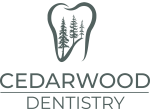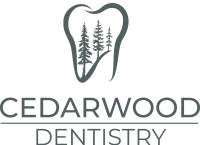Gum recession happens when gums start slowly pulling back away from the teeth. Although it’s not something that happens overnight, it’s a progression that can worsen over time. There are many reasons why patients might experience receding gums, although age is the primary factor. As we get older, it’s natural for our gums to recede. Gum recession is a common issue we see in almost all of our patients in one form or another. Here are the main causes of gum recession and how to treat it.
Contents
What Causes Gum Recession?
- Along with age, periodontal disease and bone loss can cause gum recession. Bacteria or tartar under the gumline can become infected, leading to inflammation and bone loss. Because that solid support of the bone is gone, the gums recede because the bone is what holds the gum into position.
- Tooth position is another thing that can cause gum recession. If you have a tooth that is really far forward, it’s probably not in very solid bone, or at least part of the tooth isn’t, so you might experience recession for that reason.
- Orthodontics can also cause receding gums on a patient who doesn’t have stable periodontal health. For example, if a patient has periodontal disease and does Smile Direct to try and move their teeth, that could cause gum recession.
- Grinding and micro-movements on teeth when you bite down or hit them from side to side can lead to bone loss and recession.
- Brushing your teeth too hard and mechanically trying to remove plaque can irritate the gums, causing them to recede.
Why Is Gum Recession Bad?
Gum recession is an issue because if you’re losing gum tissue, you’re also losing bone. They go hand-in-hand. If you lose bone, you’re going to lose gum. But also, if you lose gum tissue or have very thin gum tissue, you’re more likely to lose bone. At Cedarwood Dentistry, we look at a patient’s gingival biotype to gauge the thickness of the gums. Some patients have very frail, thin gums that are more likely to recede from brushing too hard or periodontal disease. Other patients have thick, tough gums that are not going to recede, regardless of their dental habits. They could not go to the dentist for ten years, and they still wouldn’t recede.
When Gum Recession Becomes a Problem
The gingiva is built of two basic parts: the keratinized tissue, which is the thick, tough, stuck-on tissue that is right next to your teeth, and then as you pull your cheek out, you can see there’s a line between the keratinized tissue and non-keratinized gum tissue called the mucogingival margin. If the gums get close to that margin, you can start to lose keratinized tissue around the teeth. Without keratinized gum tissue around that tooth, it will be irritated and difficult to keep food and plaque out from under the gum line. Popcorn kernels, for example, are especially a problem, as they can get stuck underneath the gums and cause an infection if the tissue isn’t there for protection.
Gum Recession & Teeth Sensitivity
Receding gums can also lead to issues with tooth sensitivity. Teeth have tubules that go from outside of the tooth into the nerve. They’re only present on the dentin, which is under the enamel, and the cementum, or the root surface of the tooth. Receding gums expose the root structure of the tooth and those tubules, which can cause sensitivity.

Monitoring Gum Recession
At every hygiene appointment, we monitor the health of the gum tissue. We use our periodontal probe to measure how deep the gums are, as you may have heard when we start listing “random” numbers such as 1,2,1,2,3, etc., during your exam. Those numbers measure the pocket depth of the gums. We also go through and measure the recession on the tooth. The recession is measured from where the enamel ends and the root structure begins to where the top of the gum tissue is. We record that once a year at every other appointment to monitor the progression.
How to Treat Gum Recession
There are two main ways to address gum recession: a gum graft or a filling. Gum grafts are recommended if it’s an issue with thin tissue, a loss of keratinized tissue to the point where a popcorn kernel could get stuck in the gums, or if there’s no keratinized tissue left. For our patients, we recommend a periodontist to complete the gum graft. Gum grafts are created from either the skin on the roof of your mouth or using cadaveric tissue.
If it’s not an issue with loss of keratinized tissue, then we can put a filling on the tooth. However, we don’t recommend fillings unless there’s a loss of tooth structure. For instance, if a patient is brushing too hard and gets a notch in their tooth, we suggest they stop brushing so hard, but we might also put a filling there to replace the tooth structure. If the restorative structure is lost, it can be replaced, unlike the tooth structure.
Depending on a patient’s insurance, the coverage amounts for gum grafts and recession treatments can vary.
Worried About Your Gums?
Are you concerned that your gums might be receding? Reach out to schedule an appointment at our office today so that we can take care of your dental needs.
At Cedarwood Dentistry, we cultivate dental health through personalized care. We offer a variety of dental services, including family dentistry, cosmetic dentistry, and emergency care in Midlothian, Virginia. Whether you last visited the dentist six months or six years ago, we can help bring your smile to life. Schedule your dentist appointment today by calling 804-379-9375.
Share the love!


